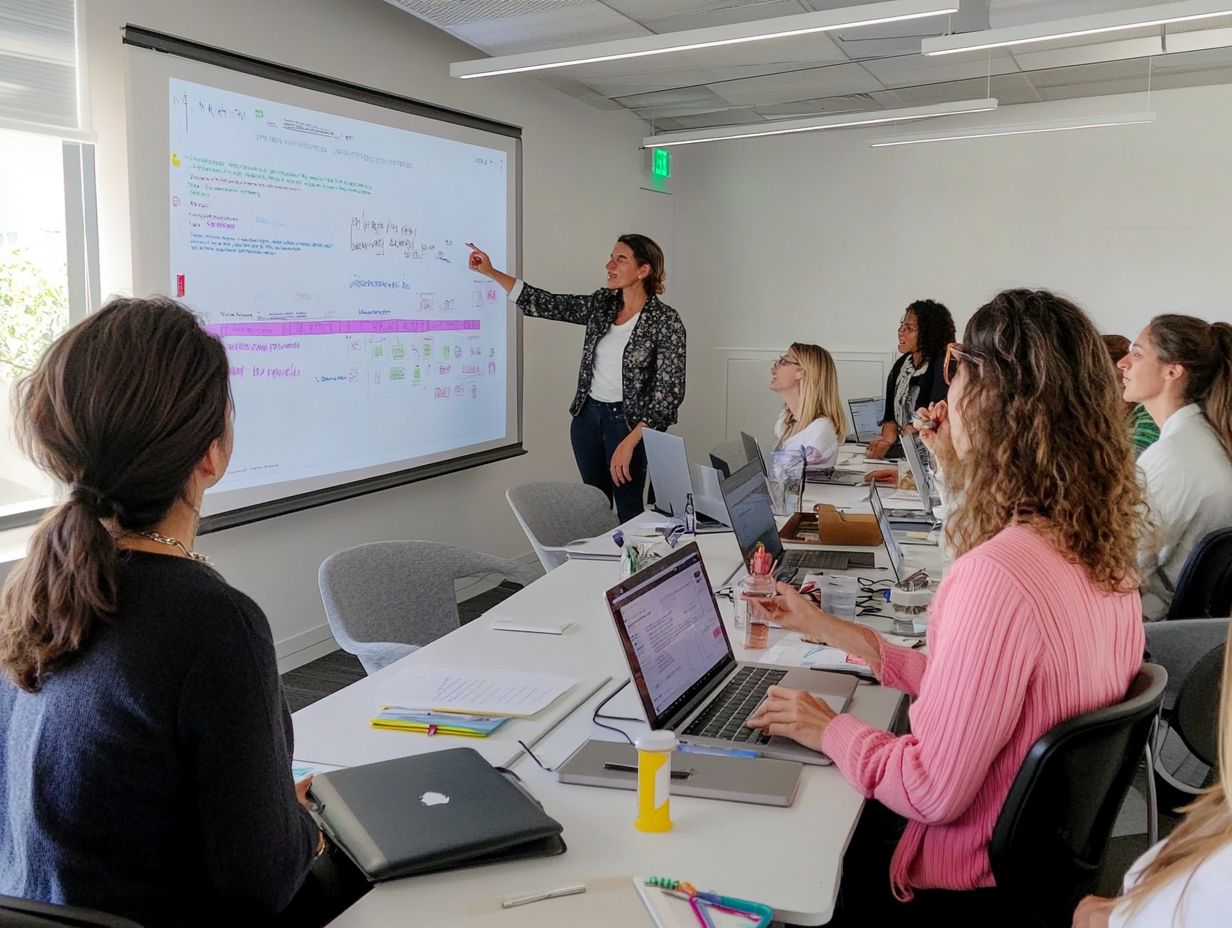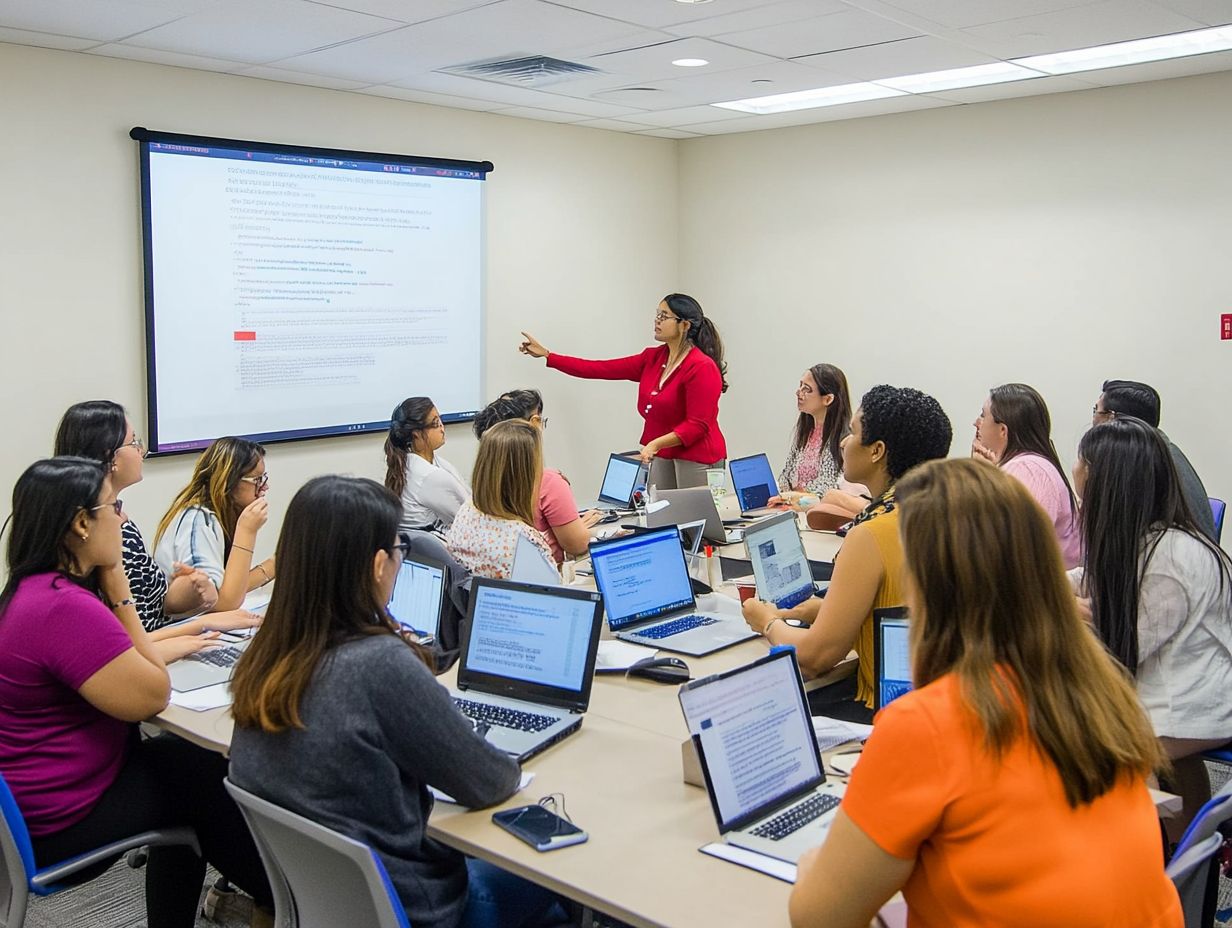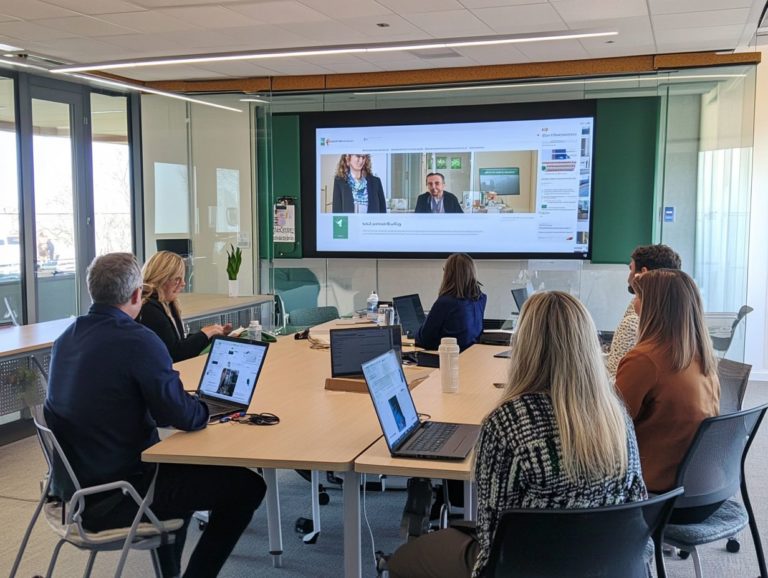What Is the Purpose of Corporate Training?
Corporate training is essential in today s fast-paced business landscape. It enhances your skills and nurtures a vibrant company culture.
This article delves into the definition and scope of corporate training, illuminating its many advantages from elevating employee performance to enhancing team dynamics.
You ll explore various training types, learn how to craft an effective program tailored to your organization s unique needs, and discover ways to measure its success.
Jump in now to supercharge your workforce and elevate your business to new heights!
Contents
Key Takeaways:

- Corporate training is essential for improving employee performance and enhancing company culture.
- Technical and soft skills training are two common types of corporate training programs.
- An effective corporate training program involves identifying training needs, setting learning objectives, choosing the right methods, and evaluating success through employee performance and feedback.
Understanding Corporate Training
Understanding corporate training is essential in today s fast-paced business environment. Organizations like Amazon and Deloitte underscore the significance of employee development.
Training is not just a trend. It helps bridge skills gaps and promotes professional growth. By fostering a culture of learning, you align training programs with your business goals, ultimately enhancing employee engagement and performance.
As online learning and e-learning platforms gain momentum, companies are increasingly embracing innovative training methods. These approaches prioritize thoughtful teaching methods and talent retention strategies, ensuring that your workforce evolves alongside the demands of the corporate environment.
Benefits of Corporate Training
Corporate training presents a wealth of advantages that can profoundly elevate employee performance and foster a thriving learning culture within your organization. When you invest in training programs today, you re likely to witness a notable uptick in productivity, leading to enhanced employee engagement and overall satisfaction.
By prioritizing professional growth through continuous training initiatives, you not only refine your employees’ skills but also bolster your corporate identity and sharpen your competitive edge in the marketplace.
Improving Employee Performance
One of your primary goals in corporate training should be to elevate employee performance. Understanding what to expect from a corporate training session can help ensure that this is accomplished through targeted training programs specifically designed to enhance skills and bridge existing gaps.
By pinpointing areas where employees may be underperforming, you can tailor your training initiatives to focus on those crucial competencies. For example, if your company seeks to boost its sales team’s effectiveness, consider implementing workshops on negotiation tactics and customer engagement strategies.
The success of these programs can be assessed using performance metrics such as sales growth, customer satisfaction scores, and employee feedback. Establishing a feedback loop allows you to gather valuable insights from participants, ensuring that adjustments and refinements to the training content are made continuously.
This iterative process not only highlights the importance of skill enhancement but also fosters a culture of continuous improvement, ultimately leading to measurable gains across various performance indicators.
Enhancing Company Culture
Enhancing company culture stands as a cornerstone of corporate training, as a robust learning environment cultivates significant employee engagement and aids in talent retention.
By aligning training programs with your corporate values, you can create an atmosphere where employees feel respected and valued. This alignment inspires active participation, leading to innovative ideas and fostering collaboration among team members.
When employees recognize that their development is a priority, they are more inclined to dedicate their efforts to a supportive, inclusive workplace. Such initiatives enable individuals to embrace their unique perspectives, ultimately transforming the workplace into a vibrant community that not only drives productivity but also fosters a genuine sense of belonging.
For more information about our training programs, contact us today!
Types of Corporate Training

Corporate training encompasses a variety of formats, notably technical training and soft skills training. Each format is tailored to address specific facets of employee development and the unique needs of the organization.
Technical Training
Technical training equips you with the specific knowledge and skills necessary to excel in your role. It effectively bridges the skills gap that many industries face today. This is essential for success today and plays a crucial part in driving both organizational success and your own job satisfaction.
Many companies are now embracing a mix of classroom and online learning, allowing you to learn at your own pace. A leading software company recently launched a training program that dramatically featured interactive simulations. This initiative led to a remarkable 30% increase in the team’s coding efficiency.
Such programs boost your performance and cultivate a culture of continuous development, keeping you engaged and fulfilled in your role.
Soft Skills Training
Soft skills training enhances your interpersonal skills, communication, and teamwork, which significantly boosts overall employee engagement in corporate environments.
In today s dynamic workplace, mastering effective interaction strengthens personal relationships and propels collective success. This training includes programs like leadership development and communication workshops, providing you with essential tools to navigate various interactions with ease.
By prioritizing the growth of these skills, organizations can experience a remarkable transformation in their corporate culture. This cultivates an environment where collaboration flourishes. You’ll become more skilled at resolving conflicts, sharing ideas, and supporting your colleagues, ultimately driving increased innovation and productivity across the organization.
Designing an Effective Corporate Training Program
Designing an effective corporate training program demands a deep understanding of training needs and the establishment of clear learning objectives. This approach ensures that your instructional design aligns seamlessly with corporate goals and addresses the specific requirements of your employees.
Identifying Training Needs
Identifying training needs is a crucial step in the corporate training journey. It enables you to pinpoint specific skill gaps and tailor programs that enhance performance.
By employing methods such as feedback loops which allow employees to share their thoughts and experiences performance reviews, and employee surveys, you can gather invaluable insights into your workforce’s capabilities. Creating a culture where employees feel comfortable sharing their challenges fosters a more dynamic training environment.
Conducting thorough assessments highlights which skills need development and guides more strategic resource allocation. This thoughtful approach ensures that your training sessions are effective and engaging, aligned with your organization’s overarching goals, ultimately leading to a more skilled and satisfied workforce.
Developing Learning Objectives

Developing clear and measurable learning objectives is essential for any corporate training initiative. It lays the groundwork for effective training design and ensures alignment with both employee engagement and corporate goals.
Think of these objectives as your roadmap, guiding both trainers and participants toward achievable outcomes. For instance, if you specify that employees should demonstrate proficiency in a new software program within three weeks, trainers can effectively tailor their materials to meet that target.
When objectives are well-defined, you ll find that employees are more motivated. They can clearly envision what success looks like, fostering increased participation and investment in the training. This ultimately leads to higher retention rates and enhanced job performance.
Invest in corporate training today. It’s not just about skills; it’s about building a thriving workplace culture!
Choosing the Right Training Methods
Choosing the right training methods can transform your corporate training programs into engaging experiences. It is essential for the success of your corporate training programs and directly influences how effectively your employees absorb and engage with the content.
An effective approach accommodates diverse learning preferences. This ensures that each individual connects with the material in a meaningful way.
For example, online learning provides the flexibility and accessibility that allows employees to fit their training around existing work commitments. However, some may find this method a bit isolating.
On the other hand, adding game-like elements to make learning more engaging injects fun into the process. It turns mundane lessons into captivating experiences. However, it might require an initial investment in technology resources.
Microlearning, in contrast, delivers concise, bite-sized content that can boost retention rates. However, it may not delve deeply into more complex subjects.
Understanding how these methods align with various learning styles can lead to more impactful training outcomes. This enhances both engagement and effectiveness.
Measuring the Success of Corporate Training
Measuring the success of corporate training is vital to assess effectiveness quickly so you can make impactful changes. This ensures that these programs are in harmony with both organizational goals and the needs of employees.
By evaluating outcomes, you can fine-tune your training initiatives to deliver maximum impact and value.
Evaluating Employee Performance
Evaluating employee performance after training is essential for grasping the true impact of corporate training initiatives. This helps in pinpointing areas for further skill enhancement.
Beyond traditional performance reviews, consider implementing various evaluation strategies. Feedback from all directions collects insights from peers and supervisors alike.
This comprehensive approach provides a well-rounded perspective on an employee s development. It highlights not only their individual performance but also their effectiveness in interpersonal interactions.
Regularly engaging with these evaluations fosters a culture of continuous learning and improvement within your organization. This enables employees to recognize their strengths and weaknesses.
This iterative feedback loop opens the door for tailored training programs that specifically target identified gaps. Ultimately, it propels both personal and organizational growth.
Gathering Feedback
Gathering feedback from participants is crucial for refining your corporate training programs. It offers valuable insights into employee engagement and the overall training experience.
By employing various methods like surveys, interviews, and focus groups, you can achieve a comprehensive understanding of the strengths and weaknesses within your training initiatives.
Surveys efficiently capture quantitative data, enabling quick analysis. In contrast, interviews allow for a deeper, qualitative exploration of personal experiences and suggestions for improvement.
Focus groups spark dynamic conversations, often uncovering insights that might slip through the cracks in more solitary feedback methods. Creating effective feedback loops ensures that this information isn’t just collected; it’s actively harnessed to drive continuous enhancements in training effectiveness.
This ultimately leads to a more skilled and motivated workforce, setting the stage for success.
Frequently Asked Questions

What Is the Purpose of Corporate Training?
The purpose of corporate training is to provide employees with the necessary skills and knowledge to perform their job effectively and efficiently. This can include training on specific skills, company policies and procedures, and professional development.
Why is corporate training important?
Corporate training is important because it helps improve employee job performance, increases productivity, and fosters a positive work culture. Understanding what makes a successful corporate training program also ensures that employees are up-to-date with industry standards and regulations, which can ultimately benefit the company as a whole.
What are the benefits of corporate training?
Some of the main benefits of corporate training include increased employee satisfaction and retention, improved job performance, better communication and collaboration among employees, and a more skilled workforce. Understanding the role of HR in corporate training can further enhance these benefits.
Looking to enhance your corporate training programs? Start implementing these strategies today for a more engaged and effective workforce!
Who is responsible for providing corporate training?
The company’s human resources or training department is responsible for providing corporate training. They design and implement programs to meet the needs of both the organization and its employees.
How often should corporate training be conducted?
Corporate training frequency depends on the company and employee needs. Some conduct regular sessions throughout the year, while others offer training only when necessary.
Can employees request specific training topics?
Absolutely! Employees can request specific training topics they find beneficial. This approach personalizes training programs and ensures employees receive relevant training to perform effectively.






